Dr Katherine Harvey
‘Episcopal Emotions: Saint-Bishops and the Unruly Male Body’
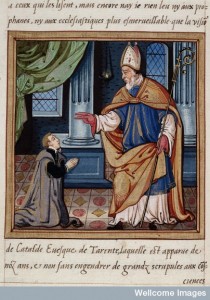 In the late eleventh century, the Catholic Church did something which profoundly affected the lives of thousands of clergymen across Western Europe: it banned clerical marriage and insisted that, henceforth, all priests must be celibate. This ruling had a very real impact on the medieval clergy. Until this time, all but the highest-ranking priests had been able to marry and father children, but by the early thirteenth-century only a handful of reprobate parish priests were openly breaking their vows of chastity. But the enforcement of clerical celibacy also had a much broader effect on medieval culture, for it created something of an obsession with clerical masculinity and sexuality, with the dangers posed by women, and with the treacherous nature of the male body. This obsession with clerical sexuality is clearly reflected in texts which relate to the cults of late medieval saint-bishops, especially hagiographies (biographies written to demonstrate an individual’s sanctity, thus proving that he was a fitting candidate for canonisation) and canonisation proceedings.
In the late eleventh century, the Catholic Church did something which profoundly affected the lives of thousands of clergymen across Western Europe: it banned clerical marriage and insisted that, henceforth, all priests must be celibate. This ruling had a very real impact on the medieval clergy. Until this time, all but the highest-ranking priests had been able to marry and father children, but by the early thirteenth-century only a handful of reprobate parish priests were openly breaking their vows of chastity. But the enforcement of clerical celibacy also had a much broader effect on medieval culture, for it created something of an obsession with clerical masculinity and sexuality, with the dangers posed by women, and with the treacherous nature of the male body. This obsession with clerical sexuality is clearly reflected in texts which relate to the cults of late medieval saint-bishops, especially hagiographies (biographies written to demonstrate an individual’s sanctity, thus proving that he was a fitting candidate for canonisation) and canonisation proceedings.
The issue is often tackled head on. A Life of the mid-thirteenth-century bishop of Chichester, St 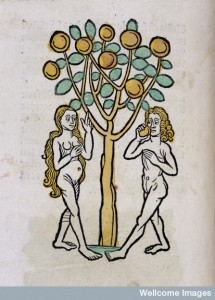 Richard Wyche, claimed that ‘he strove after continence…and so adhered to an uncorrupted path that his reputation was kept free from any imputation of defiling contact with the flesh.’[1] Other saintly bishops were believed to be virgins; Archbishop Thomas II of York was said to have died rather than comply with his physician’s prescription of sexual intercourse.[2] However, whilst straightforward chastity may have been enough for most bishops, potential saint-bishops were aiming for complete bodily purity, in imitation of Christ and of the pre-lapsarian Adam. In order to achieve this, the bishop needed not only to avoid female company, but also to achieve complete mastery of his own body.
Richard Wyche, claimed that ‘he strove after continence…and so adhered to an uncorrupted path that his reputation was kept free from any imputation of defiling contact with the flesh.’[1] Other saintly bishops were believed to be virgins; Archbishop Thomas II of York was said to have died rather than comply with his physician’s prescription of sexual intercourse.[2] However, whilst straightforward chastity may have been enough for most bishops, potential saint-bishops were aiming for complete bodily purity, in imitation of Christ and of the pre-lapsarian Adam. In order to achieve this, the bishop needed not only to avoid female company, but also to achieve complete mastery of his own body.
Medieval understandings of the body were based on the system of the four humours; the key concept in this system was the notion that health was based on the equilibrium of the humours, and illness the product of imbalance. Balance was maintained through the expulsion of various bodily fluids, including blood, phlegm and semen. If semen was not expelled through sexual intercourse, then it would have to be discharged through involuntary nocturnal pollutions. Medieval theologians were greatly concerned by the potential pollution of the priestly body in this way. Whilst, on one level, such emissions were no more than a medical necessity, they were also a reminder of man’s fallen state, and his constant vulnerability to the temptations of the flesh.[3]
Fortunately for the saint-bishop, it was possible to adopt a lifestyle which would minimise the production of semen, and thus reduce one’s vulnerability to such pollutions. Several non-naturals were influential in this respect, including food and drink, sleep and (perhaps most surprisingly) emotions. A bishop’s tears, anger and laughter could all influence contemporary perceptions of his body and sexuality, and consequently episcopal emotions are often referenced in both hagiographies and canonisation proceedings.
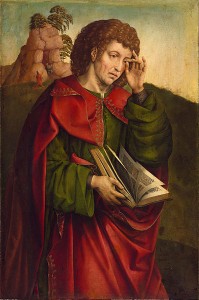
Saint John the Evangelist Weeping. Image reproduced from Wikicommons
The image of the tearful saint is familiar to any reader of medieval texts. On one level, this motif is clearly about piety: a bishop who can weep (sometimes literally) buckets whilst praying or saying mass has received the gift of tears as a sign of divine favour. However, the bishop’s tears were about more than piety. Tearful prayer would ward off the Devil and ensure that the episcopal mind remained focused on spiritual matters, and the shedding of tears also had physical consequences which would help the bishop in his battle for chastity. Men needed to expel semen because their natural complexion was much hotter than that of the female. Many holy men had used cold water to cool the body and subdue the flesh, and tears probably served a similar function. Furthermore, it was commonly held that all bodily fluids (including semen) were formed from processed blood, and were thus interchangeable. Tears were thought to be produced when heat caused the moisture of the brain to dissolve, and semen was thought to have its origins in the same organ. If too much semen was expelled from the body, then the eyes and brain would dry out and eventually be destroyed; this was said to be the fate of a monk who ‘desired’ a beautiful woman seventy times before breakfast, and subsequently died.[4] On the other hand, copious weeping could prevent the over-production of semen, by drying up the moisture from which it was formed.
Depictions of anger could also be used to comment on episcopal sexuality. Anger was universally viewed as a vice, and some medieval theologians even argued that it was a sin. However, the problem of divine anger had necessitated the development of a theory of legitimate anger, motivated by zeal and modelled on God’s righteous wrath. There thus emerged two distinct types of anger. The first, furor, was a violent, irrational, raging anger, almost a form of madness. Ira, on the other hand, was firm but justified and controlled. When attributing either of these forms of anger to his subject, a biographer was making a statement about his masculinity, or lack thereof. The man of ira was potent, active and rational, and therefore manly. In contrast, the man of furor was defined by stereotypically feminine characteristics: madness, irrationality, ineffectiveness and deceit.[5] But anger had a further dimension since, especially in its fiercest form, it was strongly associated with the heat of the male body. Since heat was also associated with lust and the production of semen, a bishop who gave way to furor would be displaying not only a worrying lack of self-control, but also a natural tendency towards uncontrollable sexuality. It is therefore unsurprising that saint-bishops are sometimes angry, but never uncontrollably so.
Anger was not the only emotion which had to be kept in check. Although saint-bishops are always good-natured, they very rarely laugh. Like excessive anger, hysterical laughter was usually associated with women, and with unruly female sexuality; it thus needed to be avoided by a holy man. Furthermore, although the connections between laughter and male chastity are not immediately apparent to the modern mind, at least one medieval medical writer found disturbing parallels:

The wind…which unleashes laughter in humans by shaking his crotch and his organs is the same as that which provokes ejaculation, and the tears which often accompany laughter gush from the eyes like semen which is ejected when the blood is shaken by the heat of pleasure.[6]
So, by presenting the saint-bishop’s emotions in a certain way, the hagiographer could demonstrate that his subject had achieved absolute mastery over his body, and was worthy of emulation by other pious men, in particular by other bishops. But, in many respects, it was the very existence of such models which was the downfall of the late medieval church: priests were expected to imitate such paragons, but very few were capable of achieving such perfection. From the perspective of many priests, one of the most positive aspects of the English Reformation must surely have been the consignment of such unobtainable standards of bodily perfection to the distant Catholic past.
[1] Saint Richard of Chichester: The Sources for His life, edited by D. Jones (Sussex Record Society, 79, 1995), p. 101. For more on St Richard’s emotions, see K. Harvey, ‘Perfect Bishop, Perfect Man? Masculinity, Restraint and the Episcopal Body in the Life of St Richard of Chichester’, Southern History 35 (2013), 1-22.
[2] Chronicles of the Reigns of Stephen, Henry II and Richard I, edited by R. Howlett (4 vols, RS, 1884-9), i. 28-9.
[3] J. Murray, ‘Men’s Bodies, Men’s Minds: Seminal Emissions and Sexual Anxiety in the Middle Ages’, Annual Review of Sex Research 8 (1997), 1-26.
[4] D. Jacquart and C. Thomasset, Sexuality and Medicine in the Middle Ages (Oxford: Polity Press: 1998), pp. 55-6.
[5] R. Barton, ‘Gendering Anger: Ira, Furor, and Discourses of Power and Masculinity in the Eleventh and Twelfth Centuries’ in R. Newhauser (ed.), In the Garden of Evil: Vices and Culture in the Middle Ages (Toronto: PIMS, 2005), pp. 371-92.
[6] Hildegardis Causae et Curae, edited by P. Kaiser (Leipzig, 1903), p.148.
© Copyright Katherine Harvey, all rights reserved.

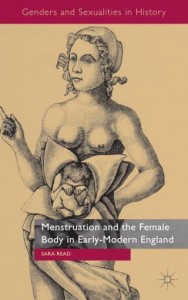
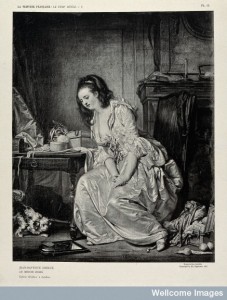
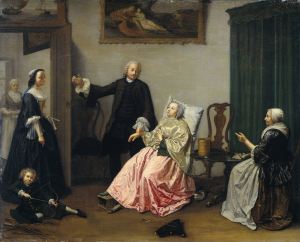
I may be mistaken, but there seems to be a little confusion about the difference between celibacy and chastity.
“Chastity” means that one remains pure. It is possible to be chaste within marriage, but total abstinence is what was required of the clergy. Thus, the sporadic attempts to enforce chastity meant that the secular clergy were expected to adopt another of the conditions required of the regular clergy, who swore to maintain chastity, poverty and obedience to their superiors.
“Celibacy” means that one remains unmarried, as it still does in French, for example. The Welsh were unhappy when this was forced on them by Norman bishops. The position of the Orthodox churches, that the parish clergy should be married, but that bishops should be unmarried monks, was one of the issues involved in the Great Schism.
However, celibacy did not always require that one remain without a female life partner and offspring. In many dioceses, at various times, it was possible to obtain a licence to keep a concubine.
This would reduce the temptation to appropriate church lands and treasure to endow one’s heirs, as one would not have any. The issuing of licences was very attractive for cash-strapped bishops. The Archbishop of Mainz whose sale of indulgences so angered Luther governed lands where a third of the priests held such licences. Many of the early Reformers married their concubines, as did Zwingli.
It was the Council of Trent that put an end to this, as one of its many contradictions of Protestant positions. The married priesthood, in this instance.
A really interesting project – thanks for writing it up!
In the comments, I’m glad to see awareness of the chastity/continence confusion that has troubled modern scholarship, and as the author of the “Chastity” entry in the Encyclopedia of Religion (2nd edition; Framington Hills, Michigan: Thomson/Gale, 2004) I couldn’t resist weighing in.
The distinction David makes is correct – but only so far. In greek and latin thought, chastity (lat: castitas, gr: sophrosyne) was a virtue of balance. It’s fair to talk about a bishop’s battle for chastity in medieval Christianity because chasitity is a virtue that any person, whatever their reproductive status, is encouraged to pursue.
Continence requires one kind of chastity, while marriage (or concubinage, which was perceived as a respectable union in the ancient and medieval world) requires another. In each case, the pursuit of virtue requires the avoidance of moral imbalance, excess, and unlawfulness. Unlike continence, chastity is never a physical virtue but it is often symbolized by the avoidance of fornication or unlicenced sexuality.
Thanks both for your comments- the point about celibacy and chastity being different things is an interesting one, and something I shall certainly bear in mind!
Chastity is the term which tends to be used in the medieval texts I am working on, but obviously ‘clerical celibacy’ has (accurately or not) become a useful and widely used shorthand for this issue.
Eucrasia, sophrosyne, castitas. This isn’t really worth flogging to death, and I lay no claim to relevant expertise, so I’ll be brief, by the standards of pedantry. I write under correction.
I’m far from clear how moral (and sexual) purity can be seen as an expression of balance comparable, perhaps, to the Hippocratic notion of εὐκρᾱσία and the related Aristotelian technical concept of σωφροσύνη.
Rather, what happened, surely, was that the everyday sense of σωφροσύνη to be seen in Plato, Xenophon, &c. — prudence, sobriety, soundmindedness — shifted through self-restraint (cf. 1 Timothy 2:15) towards being a term for total restraint in the form of virginal chastity, especially in Greek Orthodox theology.
In like manner, neo-Hippocratic “temperance” turned into a term for total abstinence from alcohol, in the early 19th century.
I am not aware that “castus” and related Latin terms ever referred to moderation and then underwent such a slippage into being terms for moral purity, as “sobrietas” and “continentia” did. “Castitas” was always about purity. One might look to Roman translations or paraphrases from classical Greek, but I suspect one would find something like “moderatio” being used for σωφροσύνη, as in Cicero.